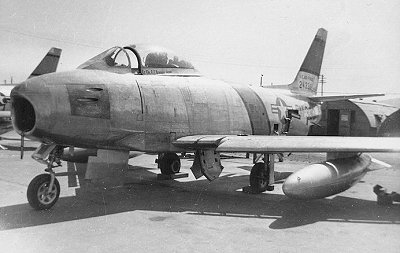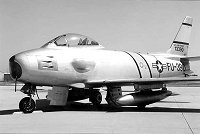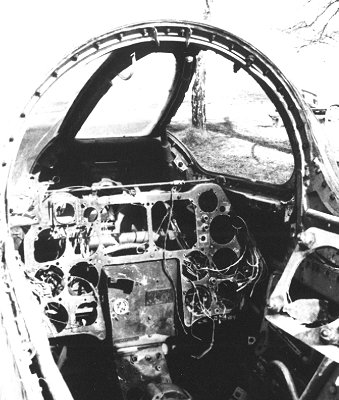RF-86A and photo reconnaissance F-86As
Photographic
reconnaissance during the Korean War initially fell to RB-17, RB-26C,
RF-51D and RF-80A aircraft. The last three were operated by the constituent
squadrons of the 67th Tactical Reconnaissance Wing (TRW), the 12th Tactical
Reconnaissance Squadron (TRS), the 45th TRS and the 15th TRSs respectively.
Later, the North American RB-45C Tornado was used on photo recce missions
over Korea. These reconnaissance aircraft proved that they could rarely
operate unescorted in North Korean airspace where MiGs were active.
Thus, it soon became apparent that a faster reconnaissance aircraft
was needed, and this fact was brought to the attention of Far East Materiel
Command (FEAMCOM). The pilots in the field felt that the Sabre would
be the only reasonable answer, especially those from the 15th TRS. However,
FEAMCOM initially resisted such suggestions, and it fell back to the
15th TRS personnel to try their own solution.
They began inspecting
4th FIW F-86As on their airfield at Kimpo, looking for places where
they might fit a camera. Fed up with constantly finding 15th TRS personnel
in his hangar, the CO of the 4th FIW, Col Harrison Thyng, agreed to
let the squadron have a salvaged airframe to experiment with. Working
in their own time, personnel from the 15th TRS soon realized that it
was possible to mount a small camera in the right hand gun bay by removing
the lower pair of machine guns, and the ammunition containers. In their
place, the camera was fitted horizontally, and shot down through the
nose, courtesy of a 45-degree angled mirror. Fuselage form was preserved
by an optical glass panel. The salvaged airframe thus became the mock-up
for what would be known as the 'Honeybucket' conversion. Soon after
inspecting the airframe, Col Edwin Chickering authorised FEAMCOM to
modify two early F-86As (48-187 and 48-217) to Honeybucket specification,
and they passed to FEAMCOM in the Fall of 1951.
The camera used
in this conversion was the K-25, mounted exactly as in the mock-up.
However, testing proved that vibration caused blurred photographs, and
it became apparent that a more radical solution would be required if
the Sabre was to be used as a photo-reconnaissance platform. Nevertheless,
the Honeybucket Sabres flew recce missions into North Korea, alongside
'regular' F-86As of the 4th FIW. These missions started as normal fighter
sweeps, and the Honeybucket aircraft were parked among the normal aircraft
to preserve their anonymity.
(missing photo)
67th TRW Honeybucket F-86A 48-217, one of the original conversions.
Note the dicing camera in the intake lip.
Following
on from the relative success of early Sabre recce operations, 5th
AF and FEAMCOM authorised a further batch of five 48-FY Sabres for
conversion, under the project 'Ashtray' tag. The conversion of this
later batch of Sabres began in October 1951, and the completed aircraft
were redesignated RF-86A. In addition, the two Honeybucket aircraft
received the RF-86A designation. The Ashtray aircraft were individually
converted, and thus each was different from the last. In general,
the compartment below the cockpit was enlarged and fitted with constant
temperature air conditioning for a forward oblique 24-inch K-11 camera
and two 20-inch K-24 cameras mounted lengthways with a mirror arrangement
to provide vertical coverage. The RF-86As could be distinguished by
the presence of camera bay fairings underneath the forward fuselage
just forward of the wings. Most RF-86As were unarmed, although some
retained a pair of 0.50-in machine guns with limited ammunition capacity.
The following aircraft were converted to RF-86A configuration: 48-183,
48-187, 48-195, 48-196, 48-217, 48-246, and 48-257.
(missing photo)
67th TRW Ashtray RF-86A 48-196. This is one of two RF Sabres to later
serve with the California ANG.
The seven RF-86A aircraft went to the 67th Wing's 15th Tactical Reconnaissance
Squadron from April 1952. On combat missions, they were usually able
to evade interception and perform missions that were more hazardous
than the typical reconnaissance flight. Only one RF-86A was lost in
combat; 48-217, which was hit by ground fire on a mission over a hydroelectric
plant at Wonsan. The pilot, Maj. Jack Williams, the squadron CO, managed
to bail out, but was found dead by the rescue helicopter. A further
two RF-86As were written off in routine flying accidents in Korea,
and another example was authorised for reclamation following combat
damage. The three surviving RF-86As were replaced by RF-86Fs in Korea
and passed through 6400th Air Depot Wing, FEAMCOM in early 1953 for
return to the US. Two of these aircraft went on to serve with 115th
and 196th Fighter Bomber Squadrons (later FIS) of the California Air
National Guard, the third to the 121st FBS, District of Columbia ANG.
The de-converted RF-86As were favoured by ANG pilots for cross-country
trips, as lots of baggage could be stored in the vacant camera bay.
48-195 was nearly lost whilst with the196th FBS, as Don Frisbie explains:
"I was making
a high-speed pass across the airfield at about 500 knots IAS and got
a forward fire light and smoke in the cockpit. I immediately retarded
the throttle to idle and started a steep climb. The fire light didn't
go out immediately, and the smoke persisted, so I stop-cocked the
engine and turned the fuel shut-off to 'Off'. The fire light went
out and the smoke and fumes quit. I ended up at about 12,000 feet
over the field, made a 360-degree turn to a high key at about 7,500
feet and made a normal flame-out pattern and landing from there. Maintenance
found a leaking fuel line that was aggravated by the very high fuel
pressure at the low altitude and very high airspeed."
Although one of the
RF-86As was subsequently lost in an accident (the 121st FBS example),
the remaining pair saw out their active service with the Air National
Guard until retired in 1958. They were scrapped at Davis Monthan AFB.
RF-86F
To replace the
RF-86As, FEAMCOM authorised conversion of three F-86Fs under Project
Haymaker. These machines had the same camera installation as the RF-86As
(i.e. without the 'cheek' fairings), though using K-14 cameras as the
main equipment. These aircraft arrived in service in early 1953.

Seen at
Kimpo in early 1953, 52-5330 is an early-type RF-86F, typified by the
lack of cheek fairings. Note also the blanked-over lower gun muzzle.
(Royce Raven)
Further to this,
North American converted eight RF-86Fs, though this time, they managed
to mount the cameras vertically, and NAA-converted RF-86Fs thus gained
the 'cheek' fairings to account for the more awkward (but better photographically)
camera installation. The NAA-built RF-86Fs used two K-22s and a single
K-17 camera. These NAA machines arrived in Korea from June 1953, and
were too late to see action in the war. At least fifteen further Sabres
were converted to RF-86F specification. Most of the RF-86Fs had a ballasted
panel fitted to the forward fuselage in place of the gun muzzle panel.
To preserve the looks of a 'standard' F-86F, 'fake' gun muzzles were
painted on this flat panel.
(missing
photo)
Though
fuzzy, this photo appears to show NAA's early RF-86F. Note elongated
canopy fairing and long, narrow cheek fairing.
67th TRW RF-86Fs
continued in service until replaced by the RF-84F, and took part in
many detachments, notably to Taiwan during September/October of 1955.
All surviving RF-86Fs were 'on paper' transferred to 21st TRS in July
1957, and were forwarded to 2723rd Air Base Sqn at Kisarazu before the
end of the year, most going on to see further service with Taiwan and
Korea under the Military Assistance Plan.
(missing
photo)
A 15th TRS Haymaker RF-86F pictured in Korea. Note 'cheek' fairings
and painted on gun muzzles. This machine was authorized for reclamation
and scrapped at Kisarazu in 1957.
It appears that
about 24 F-86Fs were converted to RF-86F specification for USAF use,
plus another 18 which were converted for the Japanese Air Self Defense
Force.
Japan
The Japanese
converted 18 F-86Fs to RF-86F specification, using modification kits
supplied by NAA. Conversion was carried out by Mitsubishi Heavy Industries
at Nagoya, starting in 1961. The first machines were delivered in August
of 1961, with the 18th aircraft passing to the JASDF in January 1962.
These RF-86Fs initially served with 501st Hikotai at Matsushima, which
was formed on 01Dec61. The squadron moved to Iruma AB in 1962, and then
to Hyakuri AB for conversion to RF-4EJ on 25Mar77
(missing
photo)
Underside
scrap view of JASDF RF-86F. Installation is the same as NAA's conversion.
Other JASDF
units which operated small numbers of RF-86Fs were Air Proving Group
at Hamamatsu AB, and HQ Squadron (Koku Sotai Shireibu Hikotai) at Iruma
AB. The latter unit was the last to fly the RF-86F, removing them from
service in October 1979.
(missing
photo)
A Japanese
Air Self Defense Force RF-86F, seen here in the colours of 501st Tac
Recon Sqn.
Following
retirement by the JASDF, a number of F-86Fs were returned to the USA
under Military Assistance terms, for conversion to QF-86F pilotless
drone/targets for the US Navy. In addition, four RF-86Fs were returned
to provide spare parts for the drones. No RF-86Fs were converted to
QF-86F configuration.
(missing
photo)
The aircraft
pictured in JASDF markings above is seen here at China Lake, having
undergone spares reclamation for the QF-86F drone program.
Following
the withdrawal of QF-86F drones, two RF-86Fs were rescued by museums;
one by Pacific Coast Air Museum at Santa Rosa CA, and one by Air Classics
Museum, Aurora IL.
(missing
photo)
Pacific
Coast' Air Museum's RF-86F 62-6428/52-4913 seen soon after it's arrival
from China Lake. Note that it has a QF-86F tail fitted. This machine
has since been fully restored.

Air Classics
Museum's RF-86F restoration was completed in early 1999; the excellent
standard of work is readily apparent. The aircraft carries a 15th TRS/67th
TRW USAF scheme, the name 'Over Exposed' has been applied on the left
fuselage.
(photo credit Jim Chybicki, Technical Director Air Classics Museum of
Aviation)
Korea
Between 11th
April and 2nd May 1958, 10 RF-86F were delivered, plus at least one
further aircraft from Taiwan. The RF-86Fs served with a separate unit
- 32nd Sqn - at Suwon. At this stage, the ROKAF had no infrastructure
to support the RF-86Fs, as there were no photo developing or interpretation
capabilities in the country. Major F-86 maintenance was accomplished
in Japan. At that time, the ROKAF had 9 bases, but only three were considered
operational.
By 1976, it
was reported that 130 Sabres of all types (F-86F, D and RF-86F) were
still in service with ROKAF, but that in 1978/9, the remaining 50 F-86F
and 18 F-86D were finally retired. However, as late as 1987, F-86Fs
and RF-86Fs were still in service at Taegu AB, and it may well be that
a number remained in service with the photo reconnaissance squadron,
plus some F-86F continuation trainers.
RF-86F 52-4492
was one of the ROKAF aircraft, and was returned to the United States
for display at Bergstrom AFB, TX by Oct91.
Taiwan
The Republic
of China Air Force (RoCAF) acquired 320 F-86F and 7 RF-86F between 01Dec54
and the end of 1958. The RF-86Fs initially served with 12th Squadron
at Taoyuan AB from 1955, and then transferred all RF-86Fs to 4th Sqn,
also at Taoyuan AB, in 1957. This unit then converted to RF-100A in
1959, but the RF-100 was never fully operational in RoCAF service. Surviving
RoCAF RF-86Fs were passed to Korea.
The
Yugoslav IF-86D
Having already purchased
a number of F-86Ds in the early 1960s, in 1963 the Yugoslavs began
conversion of its first reconnaissance F-86D aircraft. These recconnaissance
aircraft were designated IF-86D ('I' for izvidacki - reconnaissance)
in Yugoslav service. The conversion entailed the removal of the Mighty
Mouse rocket pack, and three K-24 cameras were installed in its place.
In addition, two pylons were installed under the forward fuselage
for carrying FOTAB (Foto Avio Bombe/photo aerial bomb) and SAB (Svetlece
Avio Bombe/light illuminating aerial bomb) flares. The modification
of 32 such aircraft was carried out by VTRZ 'Zmaj' (Dragon) depot
at Pleso, near Zagreb, the first IF-86D being delivered before the
end of 1963. It was initially thought that these conversions were
carried out on a further of Yugoslav AF Sabres, but it now seems that
some, if not all aircraft were from existing Yugoslav F-86Ds. In service,
the IF-86Ds retained their natural metal colour scheme until retired
from service in 1971.

(missing
photo)
Underside
of an IF-86D showing the camera windows and flare pylons. (left) At
right is a shot of stripped-out IF-86D cockpit. Prominent is the blanked
off space left by deletion of the pilot's radar scope. (both Mitja Marusko)
In the first
half of 1964, 184 ivp (Reconnaissance Wing) at Pleso received the first
of its 20 IF-86D aircraft. The Wing also used modified RF-84Gs and IT-33As
at this time. During 1965, 184 ivp disbanded, although the IF-86D unit,
352 reconnaissance eskadrille, was retained. Eventually this unit converted
onto MiG-21R reconnaissance fighters.
During 1967
a reconnaissance eskadrille was formed at Pleso, equipped with IF-86D,
and came under the command of the F-86D Wing (thought to be 83 vp) based
there. The Wing then began to train for the reception of new MiG-21F
fighters. The F-86Ds were then passed to 94 vp at Skopski Petrovac,
whose F-86Es were retired. With the large number of F-86Ds at Skopski
Petrovac, a new fighter Wing was formed, and this new unit completed
training on the F-86D to operational status within three months.